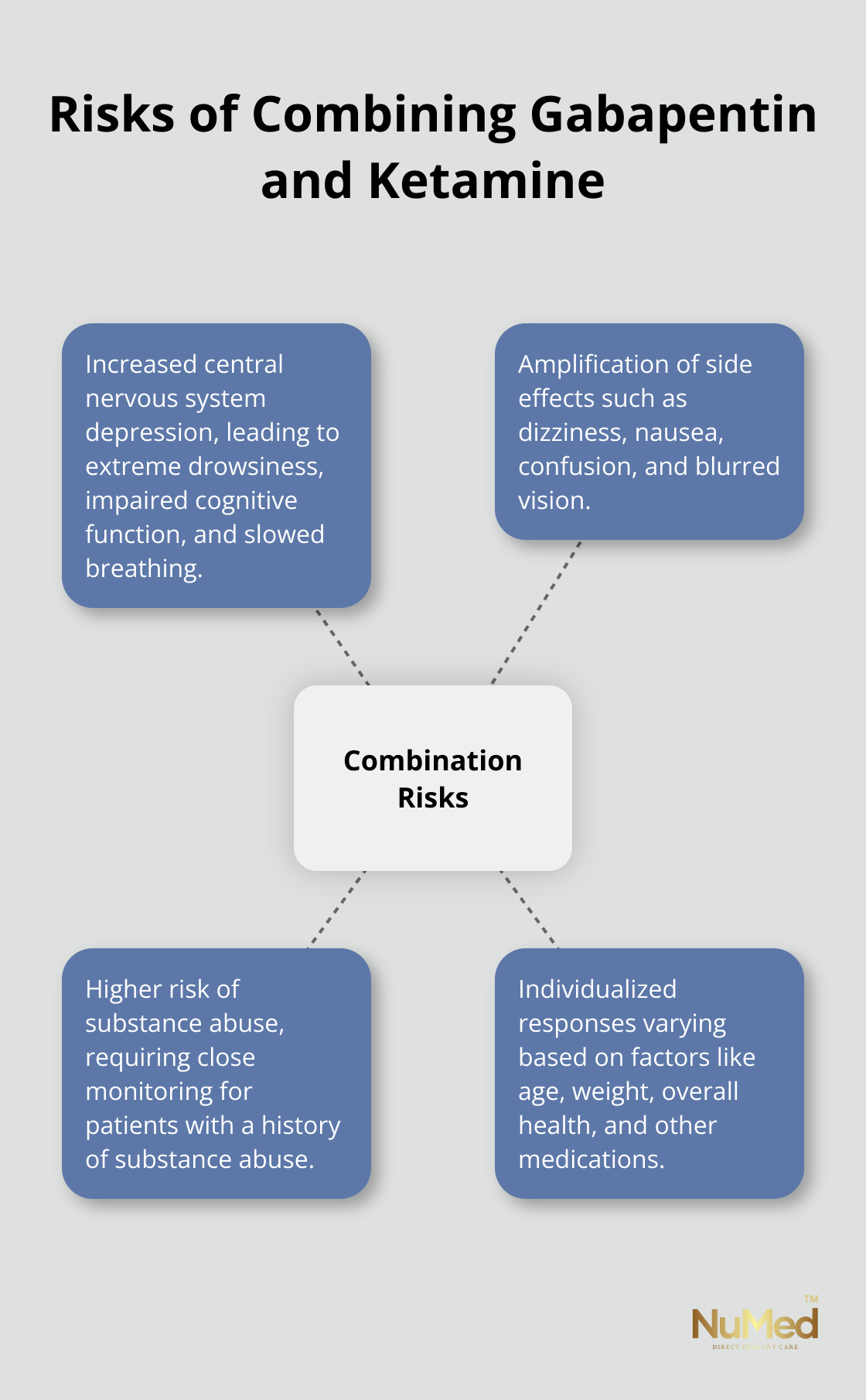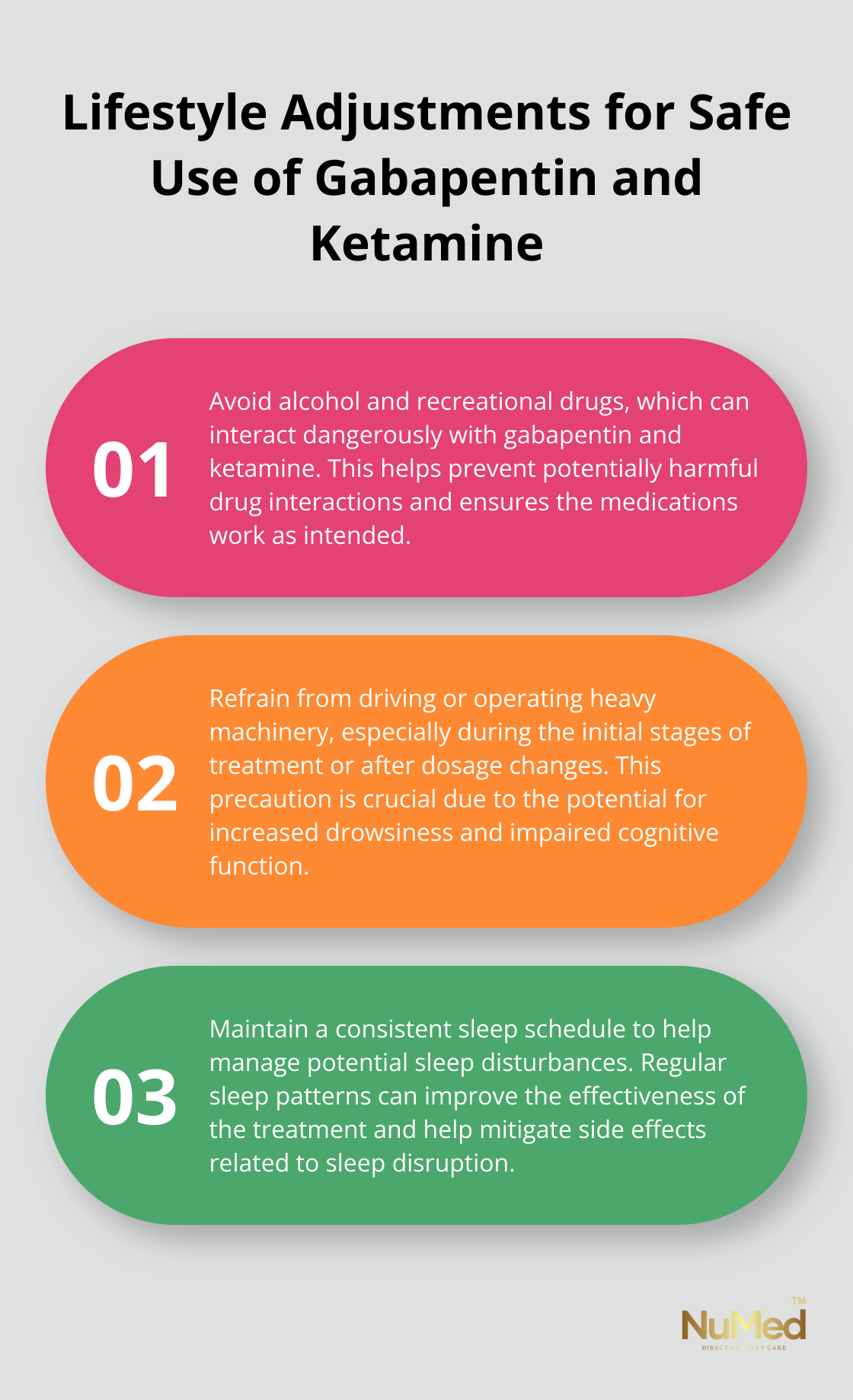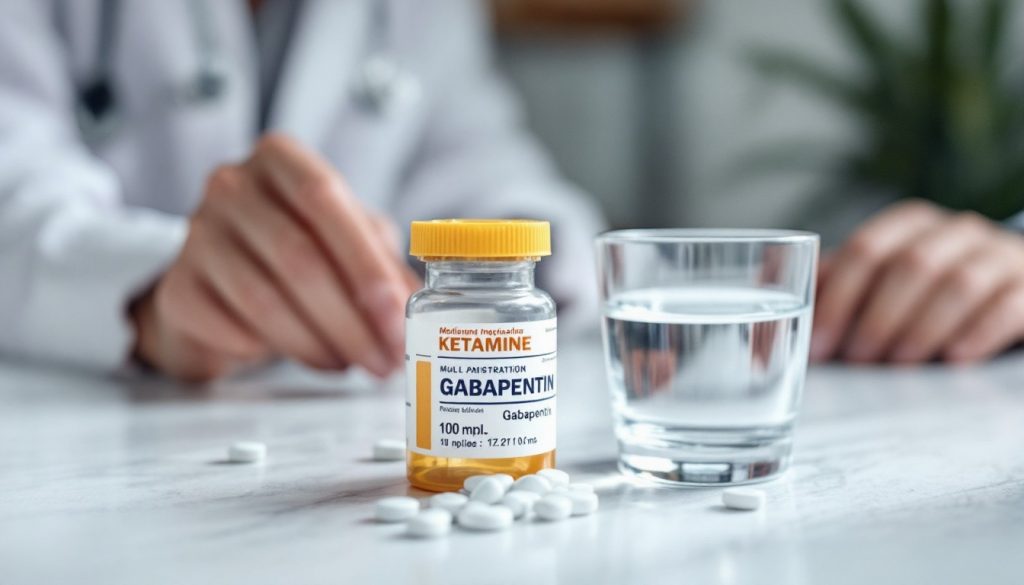At NuMed DPC, we understand the complexities of managing multiple medications. Gabapentin and ketamine are two powerful drugs that can be prescribed together in certain situations.
However, combining these medications requires careful consideration and professional guidance. This post will explore how to safely use gabapentin and ketamine together, highlighting potential risks and essential precautions.
What Are Gabapentin and Ketamine?
Gabapentin and ketamine are two medications that have gained attention in pain management and mental health treatment. This chapter provides comprehensive information about these drugs to help patients make informed decisions.
Gabapentin: A Versatile Anticonvulsant
Gabapentin, approved by the FDA in 1993, treats epilepsy and neuropathic pain. It alters the way nerves send messages to the brain. A study found that gabapentin is more effective, especially at higher doses, compared to pregabalin in treating neuropathic pain.
Common side effects of gabapentin include dizziness, drowsiness, and fatigue. These occur in about 10-20% of patients (American Journal of Psychiatry). Gabapentin can interact with other medications, particularly opioids, potentially increasing the risk of respiratory depression.

Ketamine: From Anesthetic to Depression Treatment
Ketamine, initially an anesthetic, now treats depression and chronic pain. The FDA approved esketamine, the (S)-enantiomer of ketamine, for treatment-resistant depression in 2019. Studies show that ketamine can rapidly reduce suicidal ideation, with effects often seen within hours.
Ketamine carries risks. Short-term side effects can include dissociation and increased blood pressure. Long-term use may lead to bladder problems and cognitive impairment in some individuals. A study in the British Journal of Clinical Pharmacology found that about 12% of regular ketamine users experienced urinary tract symptoms.
Combining Gabapentin and Ketamine
The combination of gabapentin and ketamine sometimes treats complex pain conditions or treatment-resistant depression. A 2018 study in the Journal of Pain Medicine found that this combination could provide enhanced pain relief in patients with chronic neuropathic pain who didn’t respond well to other treatments.
Combining these medications requires careful medical supervision. Both drugs affect the central nervous system, and their interaction can potentially amplify side effects or increase the risk of adverse reactions. Patients considering this combination should discuss the potential benefits and risks with their healthcare provider.
Safety Considerations
When using gabapentin and ketamine together, patients must follow their doctor’s instructions carefully. Regular check-ups and open communication about any side effects or concerns are essential. Patients should inform their healthcare provider about all medications they’re taking (including over-the-counter drugs and supplements) to avoid potential interactions.
The next chapter will explore the potential interactions and risks associated with combining gabapentin and ketamine in more detail, providing crucial information for safe usage.
What Are the Risks of Combining Gabapentin and Ketamine?
Combining gabapentin and ketamine can effectively treat certain conditions, but it comes with potential risks. This chapter explores the key concerns associated with using these medications together.

Increased Central Nervous System Depression
The primary concern when using gabapentin and ketamine together is the heightened risk of central nervous system (CNS) depression. Both medications act on the CNS, and their combined effects can be more potent than either drug alone. A recent study found that IV ketamine and IN ketamine significantly reduced depressive symptoms and suicidal ideation by treatment endpoint.
This increased CNS depression can lead to:
- Extreme drowsiness
- Impaired cognitive function
- Slowed breathing
- Decreased heart rate
Patients taking this combination should avoid driving or operating heavy machinery. It’s important to have a responsible adult present, especially during the initial stages of treatment.
Amplification of Side Effects
When gabapentin and ketamine are used together, side effects may become more pronounced. Common side effects that may intensify include:
- Dizziness
- Nausea
- Confusion
- Blurred vision
Risk of Substance Abuse
Both gabapentin and ketamine have the potential for abuse, and combining them may increase this risk. A recent study aimed to systematically review and meta-analyze the effectiveness of psychological and pharmacological treatments for IEDs, drawing insights from both approaches. Patients with a history of substance abuse require close monitoring if prescribed this combination.
Individualized Responses
Each patient may react differently to the combination of gabapentin and ketamine. Factors such as age, weight, overall health, and other medications can influence how an individual responds to this treatment.
Healthcare providers should conduct thorough assessments before prescribing any medication combination. They must consider each patient’s unique medical history and current health status to minimize risks and optimize treatment outcomes.
Monitoring and Adjustment
Regular monitoring is essential when combining gabapentin and ketamine. Healthcare providers typically recommend:
- Weekly check-ins during the first month of treatment
- Blood tests to monitor kidney and liver function
- Cognitive assessments to evaluate any impact on mental clarity
Dosage adjustments may become necessary based on patient response and side effect profile. Patients must communicate any changes in their condition promptly to their healthcare provider.
The next chapter will discuss safe combination guidelines, providing practical advice on how to minimize these risks and ensure the best possible outcomes when using gabapentin and ketamine together.
How to Safely Use Gabapentin and Ketamine Together
Consult Your Healthcare Provider
The first step in the safe use of gabapentin and ketamine together is to consult with a qualified healthcare provider. Your doctor will assess your medical history, current health status, and treatment goals to determine if this combination suits you. They’ll also consider potential drug interactions and individual risk factors.
A study found that the risk ratio for at least 50% pain relief after 6 to 12 weeks of treatment was 1.1 (95% CI 1.01–1.2) for treatment compared to placebo, with a Number Needed to Treat (NNT) of 6.9. This highlights the importance of professional guidance in determining the effectiveness of treatment combinations.
Follow Dosing Instructions Precisely
Proper dosing is key when combining gabapentin and ketamine. Your healthcare provider will likely start with low doses of both medications and gradually increase them based on your response. It’s essential to follow dosing instructions precisely and never adjust dosages without consulting your doctor.
Evidence-based strategies to minimize the risk of medication misuse include the use of prescription drug monitoring programs, informed consent, and careful adherence to prescribed regimens.
Monitor for Side Effects
Vigilant monitoring for adverse effects is important when taking gabapentin and ketamine together. Common side effects to watch for include:
- Dizziness
- Drowsiness
- Confusion
- Nausea
- Changes in mood or behavior
Keep a symptom diary and report any new or worsening side effects to your healthcare provider immediately.
Make Necessary Lifestyle Adjustments
While taking gabapentin and ketamine, certain lifestyle adjustments may help ensure your safety and the effectiveness of your treatment. These may include:

- Avoid alcohol and recreational drugs (which can interact dangerously with these medications).
- Refrain from driving or operating heavy machinery (especially during the initial stages of treatment or after dosage changes).
- Maintain a consistent sleep schedule to help manage potential sleep disturbances.
- Stay hydrated and eat a balanced diet to support your body’s ability to process these medications effectively.
Final Thoughts
Combining gabapentin and ketamine can effectively treat certain conditions, but it requires careful consideration and professional guidance. We at NuMed Direct Primary Care understand the complexities of managing multiple medications and offer personalized care to help you navigate your treatment journey. Our approach focuses on preventing illness by addressing root causes and fostering a strong patient-practitioner relationship.
We provide comprehensive lab services, functional medicine, and health coaching to tailor treatments to your unique needs. If you’re considering gabapentin and ketamine as part of your treatment plan, or if you have any questions about managing your medications, don’t hesitate to reach out to a healthcare professional. With the right guidance and support, you can make informed decisions about your health and work towards achieving your wellness goals.
NuMed Direct Primary Care offers personalized care to help you safely manage your medications, including combinations like gabapentin and ketamine. Our team will assess your individual needs, monitor your progress, and make necessary adjustments to ensure the best possible outcomes. Contact us today to learn how we can support your health journey.
















